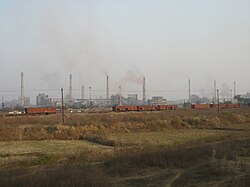Bokaro Steel Plant
This article has multiple issues. Please help improve it or discuss these issues on the talk page. (Learn how and when to remove these template messages)
|
 | |
| Company type | part of SAIL |
|---|---|
| Industry | Steel |
| Founded | 1964 |
| Headquarters | Bokaro, Jharkhand, India |
| Products | Hot Rolled & Cold Rolled |
| Revenue | $900 million(2022)[1] |
| $75 million(2022)[2] | |
Bokaro Steel Plant (BSL) is located in the Bokaro district of Jharkhand. It is the fourth integrated public sector steel plant in India built with Soviet technology. It is the second largest steel plant in India after Bhilai Steel Plant and 3rd largest in Asia in terms of area(10 km x 5 km).
History
[edit]
Bokaro Steel project in the late 1950s, as political elites in several other states of India made the case for building a steel plant in Bokaro rather than in Bihar.The factors other than natural endowment were involved in the decision — after all, rich deposits could be found in various locations throughout the country. As several scholars have noted, certain non-economic imperatives related to the project of post-colonial nation-building played a significant role.
The achievement of Self-Sufficiency is a long process, and even as PM Jawaharlal Nehru worked towards that goal, the nation was drawn into closer involvement with the Soviet Union. In September 1964, the Soviets confirmed their readiness to assist in the construction of the huge Bokaro Steel Plant.[3]
The Soviet Union has traditionally managed to secure generous returns on its aid program in India.The principal redeeming feature of the preliminary agreement between Bokaro Steel and Gipromez is the Russian commitment that they would see it through to 4 million tonnes ingot capacity, though the phasing and completion dates.[4] Heavy Engineering Corporation with help of Gipromez developed the equipment according to Russian specifications.[5] BSL engineers were trained by the Soviet engineers, there was also a dedicated Russian colony for their stay.The prestigious firm of M. N. Dastur and Company was actively associated with the early planning of the project and had the competence to assess critically the proposed Soviet designs, however, muscled out by the Soviet negotiators from the final aid contract to the chagrin of an articulate and aroused public opinion cutting across most political parties.[6]
The steel plant was incorporated as a limited company in 1964.[7] It was later merged with the state-owned Steel Authority of India Limited (SAIL).[8] The steel plant started operation in 1972 with Bokaro city construction completed.

Production
[edit]Currently, it houses five blast furnaces with a total capacity to produce 5.8 MT of liquid steel.[9] The plant is undergoing a mass modernisation drive after which its output capacity is expected to be 12 MT.
An upgrade of the plant was also done in the 1990s in its steel refining units and continuous casting machines. Initially, about 64 moujas (a mouja may have several village units) had been acquired for the plant. Of the total land acquired, only 7,765 ha was used to set up the steel plant. The rest has been given by SAIL to the private parties without government’s approval.
Products
[edit]Bokaro Steel Plant is designed to produce a wide range of products:
- Hot rolled coils
- Hot rolled plates
- Hot rolled sheets
- Cold rolled coils (CRM)
- Cold rolled sheets
- Tin mill black plates
- Galvanised plain and corrugated sheets
- Oxygen gas
- Hydrogen gas
- Coke oven byproducts
- Railway tracks
- DMR grade
- Steel pipes
- low weight Stainless steel
- Jackal steel
- SeQR TMT Bars
Bokaro has provided a strong raw material base for a variety of modern engineering industries including automobile, pipe and tube, LPG cylinder, barrel and drum producing industries.
Financials
[edit]Bokaro Steel Plant has achieved a net profit of Rs 600 crore during the financial year 2022-23, which is 45% of SAIL's total profit of Rs 1330 crore.[10]
Collaboration
[edit]Bokaro steel plant uses majority of the Blast furnace equipment from Heavy Engineering Corporation, a PSU from Ranchi and some of the equipment's are used from Larsen & Toubro.[11]
References
[edit]- ^ "SAIL Revenue crosses rupees One Lakh Crore, Bokaro Steel achieves best ever profitability". 23 May 2022.
- ^ "Bokaro Steel Plant creates record of production in history of 50 years: Amarendu Prakash".
- ^ Intelligence Memorandum, Indo-Soviet Relations (PDF). CIA. 4 December 1972.
- ^ "Bokaro, made in the USSR" (PDF). The Economic Weekly. 17 October 1964. Retrieved 28 July 2024.
- ^ d'Mello, Bernard (1988). "Soviet Collaboration in Indian Steel Industry, 1954-84". Economic and Political Weekly. 23 (10): 473–486. JSTOR 4378206.
- ^ Desai, Padma (1972). The Bokaro Steel Plant: A Study of Soviet Economic Assistance. North-Holland Publishing Company. ISBN 9780444103888.
- ^ Nirmal Sengupta (1979). Destitutes and Development: A Study of the Bauri Community in the Bokaro Region. Concept Publishing Company. pp. 25–. GGKEY:73SPC2220UQ.
- ^ Steel Authority Of India Limited
- ^ "BOKARO STEEL PLANT - PRODUCT BASKET".
- ^ "Bokaro Steel Plant creates record of production in history of 50 years: Amarendu Prakash".
- ^ d'Mello, Bernard (1988). "Soviet Collaboration in Indian Steel Industry, 1954-84". Economic and Political Weekly. 23 (10): 473–486. JSTOR 4378206.
Further reading
[edit]- Sutinder Bhatia (1 January 1991). Bokaro steel plant: some economic aspects. Popular Prakashan. ISBN 978-81-7154-540-7.
- Padma Desai (1972). The Bokaro steel plant: a study of Soviet economic assistance. North-Holland Pub. Co. ISBN 978-0-444-10388-8.
- Sengupta, Somnath (14 May 2018). "Legends of Indian Football : Peter Thangaraj". thehardtackle.com. Mumbai: The Hard Tackle. Archived from the original on 13 April 2021. Retrieved 7 October 2022.
